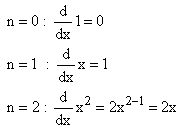3.1.1 Derivative of Constant Function
3.1.2 Derivative of Identity Function
3.1.3 The Sum Rule
3.1.4 The Product Rule
In particular
3.1.5 The Chain Rule
y = f(u), u = g(x), f and g differentiable.
Then
3.1.6 Implicit Differentiation
Suppose the function f(x) is defined by an equation: g(f(x),x)=0, rather than by an explicit formula.
Then g is a function of two variables, x and f.
Thus g may change if f changes and x does not, or if x changes and f does not.
Let the change in g arising from a change, df, in f and none in x be a(f,x)df, and let the change in g from a change, dx, in x and none in f be b(f,x).
The total change in g must vanish since g is a constant, (0), which gives us
a(f,x)df + b (f,x)dx = 0
or
3.1.7 The Quotient Rule
In particular,
3.1.8 The Power Rule
hence,
implies

General Derivative Formulas:
1) 2) 3) 4) 5)  6)  7) 8) 9) 10)  It is called Quotient Rule. It is called Quotient Rule.
Derivative of Logarithm Functions:
11)
12) 13)  14) 
Derivative of Exponential Functions:
15)
16) 17) 18) 19)
Derivative of Trigonometric Functions:
20)
21) 22) 23) 24) 25)
Derivative of Hyperbolic Functions:
26)
27) 28) 29) 30) 31)
Derivative of Inverse Trigonometric Functions:
32)
 33)  34) 35) 36)  37) 
Derivative of Inverse Hyperbolic Functions:
38)
 39)  40) 41) 42)  43)  |
No comments:
Post a Comment